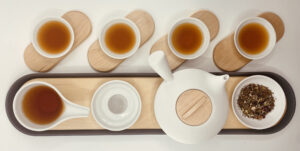One of the more interesting challenges of my job is finding that perfect cuppa for each individual. Names of teas are not always descriptive enough, and all of the shiny, silver canisters look the same. Free smell-samples help to determine what we will actually enjoy drinking, and hearing how various customers liken scents to teas has some serious poetic potential. It is also very entertaining.
Oolongs get the most varied reactions. First of all, what are all of those o’s doing in a single word? This is the first obstacle – sounding the word out, Oooolong. What is that? I hear this a lot. As tea is becoming more trendy, many people have at least heard the word even if they know nothing about them. So where do they fit among the green/black tea balance of health and wellness and more importantly, taste?
Chocolate, hazelnut, peaches, apricots, lilacs, honey, and cinnamon are among the more pleasant words people liken to their favorites. Those reactions and descriptions that make me chuckle range from smelling like a flannel shirt, reminding one individual of her grandfather in India, a walk through fresh-cut alfalfa, ripe apple orchards, smoke, fresh baked bread, or one of my favorites, glazed donuts (without any of the calories, of course).
Apart from our ginseng oolong, none of our oolongs are actually blended or flavored, so what gives them such a defining aroma? It’s all in the processing.
The basics: Traditionally produced in Taiwan and China, oolongs fall somewhere between greens and black teas when it comes to processing. The whole leaf is picked and partially oxidized. The leaves are usually shaken and edges bruised to break the cells inside and on the surface of the leaf so that oxidization can occur. There are two basic categories that fall under the oolong umbrella. Some open-leaf oolongs that take on a darker character are allowed to oxidize 70%, while the greener colored or balled oolongs are allowed to oxidize up to 30%. Throw in various growing conditions and heights and you have a wide range of taste experiences all through one type of tea – oolong.
It is also interesting to note that oolongs withstand multiple infusions. You can use the leaves several times before the whole leaf is even unfurled. I’m on my third pot with this Rou Gui Rock Tea and it keeps getting better…reminds me of my mom’s fresh Honey Bulgar Bread. That’s just my opinion.
Go ahead. Sniff some tea leaves. Tell me what you think. Make me smile 😉
Your Barista,
Katie

